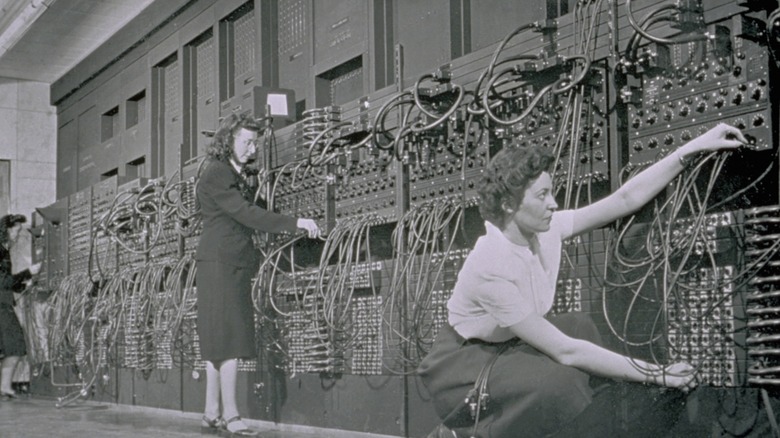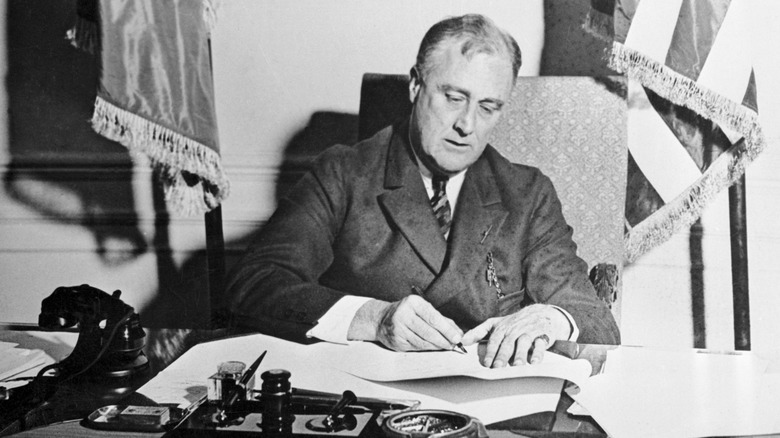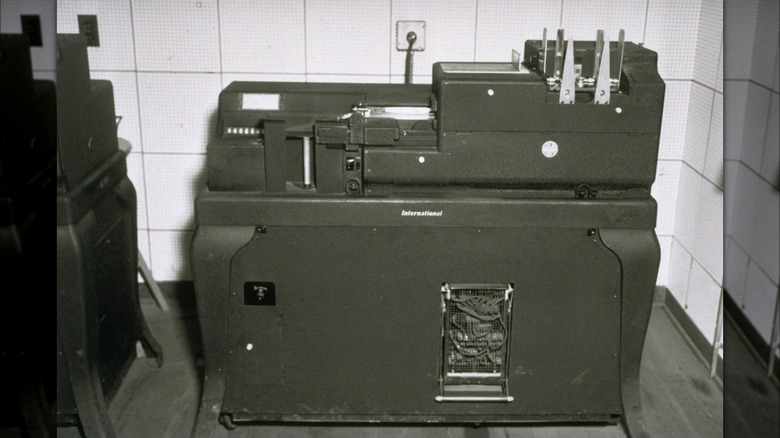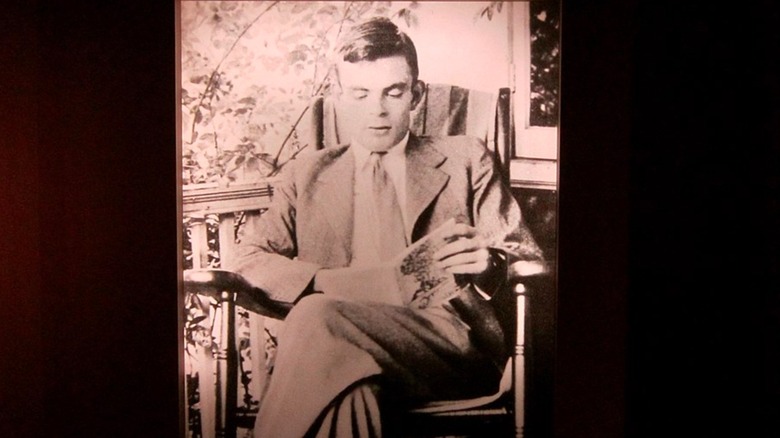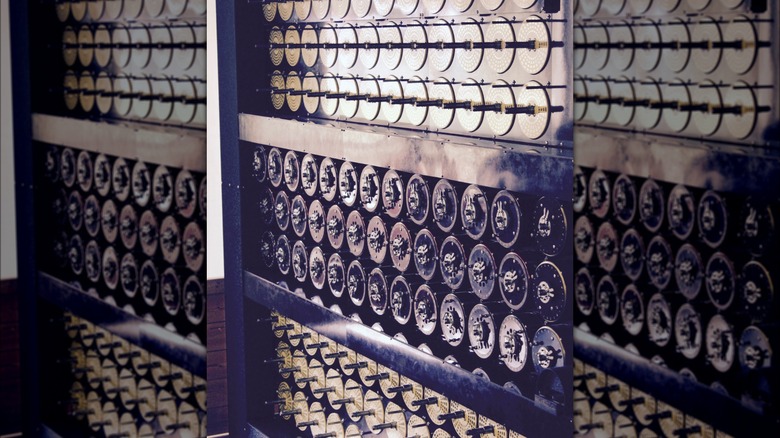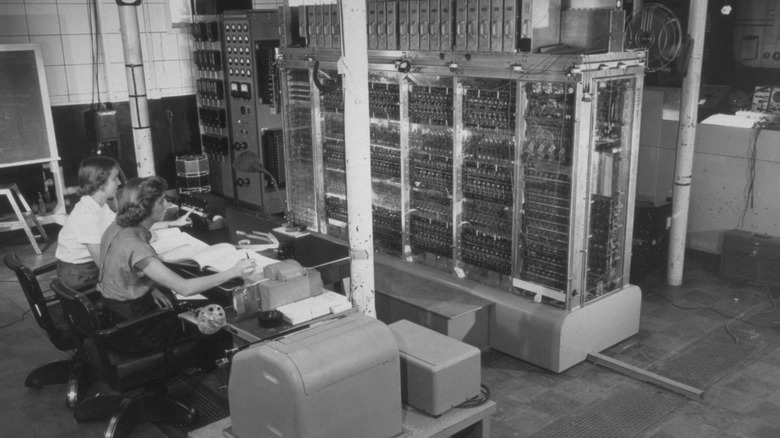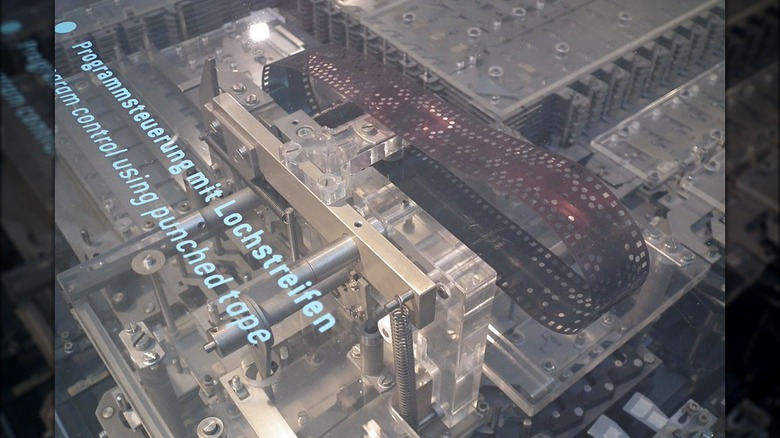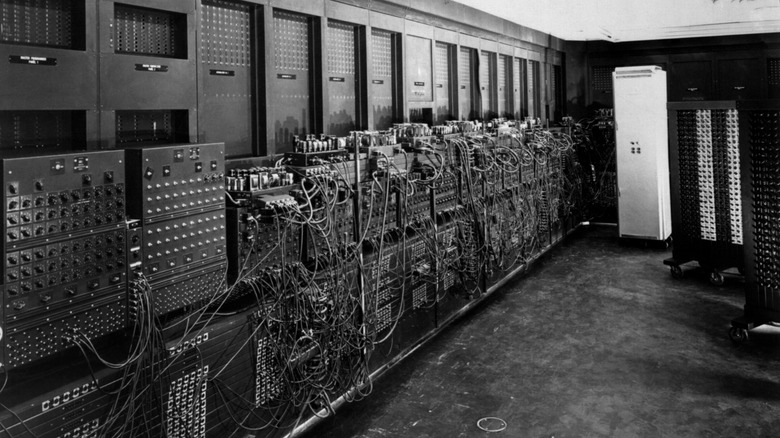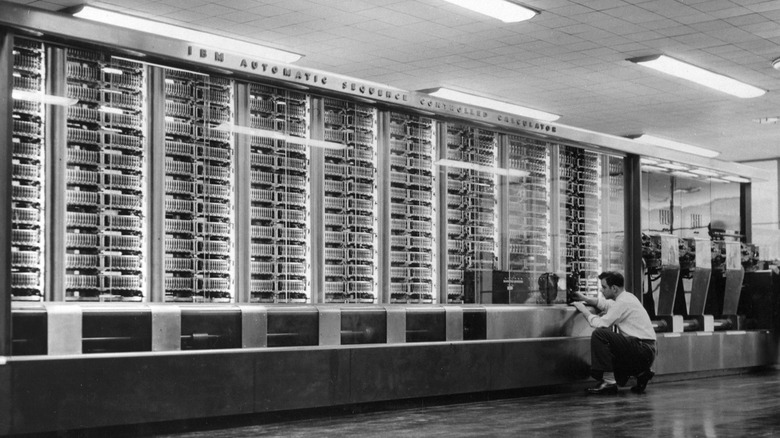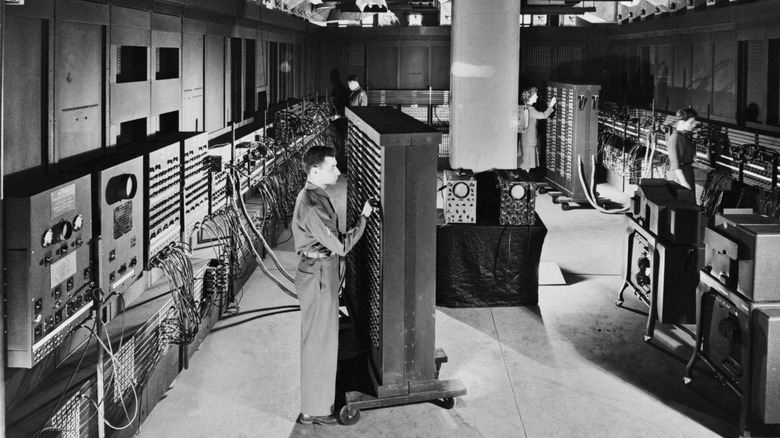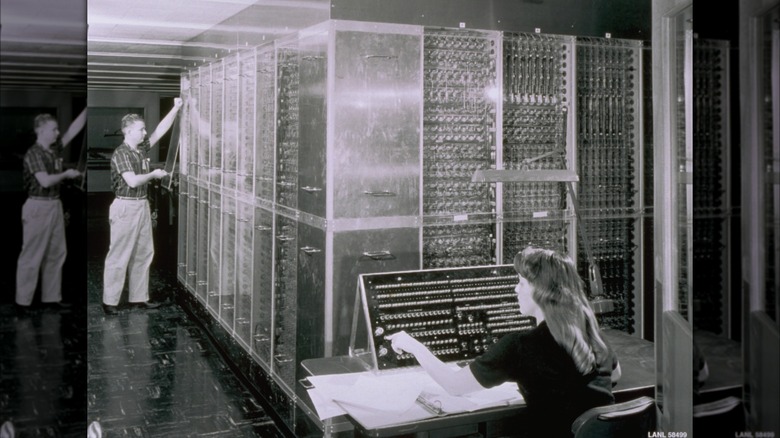How World War II Accelerated Computer Technology
When war broke out on the European continent in 1939, few countries were prepared for what would happen in the following years. WWII introduced the world to the horrors of mechanized warfare, and though leaders generally wanted to avert another worldwide conflict, they continued to develop military hardware to be prepared anyway. Most advancements in military preparedness came in mechanical forms, with aircraft, ships, and heavy weaponry being the focus. But the German Blitzkrieg into Poland and then France changed everything.
Technology had been on a rapidly developing curve for many years, but electronics were still in their infancy. Germany's attempted domination of the European continent prompted British military leaders to find technological solutions to defend the British Isles, which led to the creation of radar. Japan's attack on Pearl Harbor awakened the sleeping American giant, and the might of the American people went full force into preparing for and executing a war strategy meant for only one thing: to defeat the enemy.
The American industrial base was virtually limitless, providing for factories to produce ammunition and machines for the war effort, but a sudden push for technology accompanied it. With the technological push came many brilliant minds who came together to create mechanical and electronic devices that would become the foundations for everything to eventually become a modern computer. Dedication to the defeat of tyranny fundamentally accelerated computer technology — here's a look at how that unfolded.
Office of Scientific Research and Development
President Roosevelt authorized the establishment of the Office of Scientific Research and Development in 1940, which was before the country entered the war but was created due to France having fallen to Germany. It was tasked with expanding the technological capacity of the country with an eye toward possible involvement in the war in Europe and a realization the American military was unprepared. Until then, the government had no significant role in research and development, with most innovations coming from offices within individual departments. Furthermore, much of the scientific advancements of the period had come from Europe, with Germany playing an outsized role.
The OSRD held a broad mandate to get things done and was also given wide latitude to work independently. This allowed ideas to flourish, and tests were administered with a minimal amount of red tape. As a result, projects flourished in many areas, from chemistry to physics, which led to breakthroughs that led to such things as the Manhattan Project. Furthermore, technology was integral to the office, and the development of radios and electronics would also be turned back to help develop concepts in physics and chemistry. This office ended up being utterly consequential to every technological achievement that happened throughout the entire period of WWII.
International Business Machines
The U.S. Census utilized a tabulating machine built by Herman Hollerith for the 1890 census. It worked so well that a company was founded that became International Business Machine (IBM). Its punch card tabulators ruled government processes for decades before WWII and continued in use well afterward. While these were not computers, they offered a mechanical means of sorting and tabulating figures, which proved invaluable for processes such as keeping inventory and tracking figures such as tax revenue and, most famously in the 2000 election, voting.
These machines made by IBM did not so much calculate numbers as they kept track of numbers to be calculated, which was invaluable for keeping track of figures for something as large as the federal government. They also became so useful and ubiquitous within government and large corporations that boxes upon boxes of punch cards were used every day, especially during wartime. While these were not computers, the punch card system became the earliest form of data storage and was used extensively by cryptographers, who went through 2 million per week. The contribution and proliferation of these machines to computers lie in the ready-made storage system that was easily converted to the earliest computers.
Although IBM contributed heavily toward the American war effort, it is worth mentioning that these same punch card machines were used by the Axis Powers to manage concentration camps as well. Not only were the machines used by the regime, but IBM CEO Thomas Watson also gave official company support to its products in Germany all the way through 1945.
Alan Turing
Among the dozens of brilliant minds assembled in the U.S. and the U.K. to crack German encryption, Alan Turing holds a special place of significance for his contributions. Born in 1912, Turing excelled in academics and showed a flair for mathematics in particular. He graduated from King's College and later received a Ph.D. from Princeton, working on concepts regarding the possibilities of computations and the idea of a universal machine that could compute anything computable. After showing so much potential and an adept understanding of complex mathematical theories, he joined the Government Code and Cypher School in Cambridge as war loomed on the horizon in 1938.
Turing's scholarly work laid out many ideas that have since become the bedrock for modern computers. The Turing machine is one idea that describes not a physical machine but conceptualizes that machines can calculate functions if an algorithm that can compute them exists. This, in essence, describes how a computer is a possibility. He later published a paper asking whether a machine is capable of thinking, setting the stage for artificial intelligence much later.
However, his greatest contribution resides in the work he did in helping to decrypt the Enigma code, which is how the Germans sent encrypted messages through the chain of command. The German military relied on an intricate and complex machine called Enigma that was used to send and receive encrypted messages. It seemed impossible to break as the design allowed for billions of possibilities of encryption.
[Featured image by Ank Kumar via Wikimedia Commons | Cropped and scaled | CC BY-SA 4.0]
Bombe
Alan Turing's work in code breaking involved a crew working in Bletchley Park in England. Using the principles he had developed in the years preceding this project, the team built an electro-mechanical machine for breaking the Enigma code called Bombe. Polish intelligence officers had previously decrypted German signals as early as 1920, but additional components had been added to the Enigma machine that added encryption possibilities by an order of magnitude. This was when the machine became seemingly uncrackable and why an even more complex machine was needed to crack it. The only problem was that no such machines existed in the 1930s.
To crack the code of an incredibly complex device requires another device of increased complexity. The machine they created was called Bombe. It stood nearly seven feet tall and seven feet wide, weighing a ton. It worked by assembling what was essentially 36 variations of the Enigma machine, each containing precise internal wiring of an individual German device. Britain built more than 200 of these machines to decode up to 5,000 intercepted messages per day.
This could often be done in a few hours, but sometimes it failed altogether. Regardless, those messages that were decoded provided a wealth of intelligence, allowing the Allies to anticipate attacks and exploit weaknesses. This work provided invaluable experience and expertise with automated calculations that would go into other computational devices for the duration of the war.
George R. Stibitz
While monumental efforts were put forth in deciphering encoded messages of the enemy, other efforts were needed to manage such an enormous operation as the Allied effort to defeat the Axis powers. Mathematics would be required for tracking troops, equipment, and supplies, as well as calculating trajectories of munitions used in targeting for a variety of weapons systems, which was crucial to successful combat operations.
George R. Stibitz had been working on methods to automate a way to perform calculations with a machine in the '30s. He created a device using electrical relays and light bulbs that could do addition. The device had several small light bulbs in which an illuminated bulb represented a "1" digit, and an unlit bulb represented a "0" digit. With a set pattern of ones and zeroes, his machine could add figures together. This was the first binary code, which is the foundation for all computers today. Once he refined his invention, the world's first digital calculator was born.
The U.S. Military put his device into use in 1943. It was built from 440 relays and had a seven-number memory capacity. These machines were rather large, and several of them were installed in rooms to perform complex calculations, with successive improved models coming online throughout the war. The largest of these were installed in 1946 and 1947, weighing 10 tons and made up of thousands of relays. The importance of binary code is monumental, and the existence of computers today can be traced directly back to Stiblitz.
Konrad Zuse
While most people prefer to concentrate on the achievements of the Allies in WWII, it would be folly to ignore the accomplishments of the many brilliant minds of Germany, which had long been a center of scientific and academic achievement. Konrad Zuse worked in Berlin in the 1930s and had a keen interest in the development of computational machines. As such, he created in his garage a binary digital programmable computer in 1938. However, it proved to be unreliable and would not be replicated.
Zuse went on to create improved versions of the Z1 computer, culminating in the Z4, which is said to be the first usable programmable digital computer. Although he lived in Germany, little information exists to suggest that his work had any major involvement or influence on the regime. However, his work after the war proved to be consequential to the further development of computers. He founded a company in 1946, which would be the predecessor of the later tech startups such as Steve Jobs and Steve Wozniak's Apple Computer in the late '70s.
Von Neumann architecture
Born in Hungary at the turn of the century, John von Neumann showed much intellectual promise when young, eventually earning a doctoral degree from a prestigious European school and later being invited to Princeton as a lecturer on quantum theory. His time at Princeton was punctuated by the onset of WWII, which resulted in him being drafted to work on the Manhattan Project.
Among the advanced principles that von Neumann worked on and created, one related to computers is now known as von Neumann architecture. This principle elucidated the concept of a stored-program computer. Early computational machines were hard-wired to perform a single function, such as arithmetic. To program them to do something else meant physically tearing them down and altering the wiring and relay setup to alter its functions.
Von Neumann suggested a system that could have its instructions read by the machine and use that to manipulate data fed into the computer, which basically describes what modern computers do today. This architecture found its way into research in the later years of the war, becoming foundational to the nascent computer industry as it progressed.
Harvard Mark I
Harvard University was intricately involved in the functions of government research during the war. With a large pool of extremely intelligent and intellectual students and professors, Harvard represented a wealth of knowledge from which the government could draw for technical expertise. During the height of hostilities of the war and at a time when military leaders sought to use every resource possible to achieve victory, Harvard and IBM worked together to fabricate the Automatic Sequence Controlled Calculator, later known simply as Mark I.
This was a 70-ton electro-mechanical leviathan installed on campus in 1944 that was used to perform the most complex and numerous calculations ever devised up to that time. Howard H. Aiken designed it to solve the advanced problem he encountered while performing research and found support from the Harvard division that is known as the School of Engineering and Applied Sciences today. What he designed was a machine that could perform advanced calculations based on changing inputs. This differed from a calculator that could arrive at a solution based on the function of the input of numbers, whereas a computer can perform calculations that would be fed into successive operations to arrive at a solution.
Previously, the only way to do that was to use what was then called computers, rooms full of mathematicians working out problems to arrive at solutions — George Stibitz suggested that humans would henceforth become known as operators. The Mark I could perform the same functions without error and in record time, and is now considered the first computer which could be programmed to execute complex calculations. This made it invaluable for a number of projects at the time, most importantly, the Manhattan Project.
Electronic Numerical Integrator and Computer (ENIAC)
The University of Pennsylvania, another school in the Ivy League with Princeton and Harvard entrenched in the war effort, also contributed to the military with scientific research. At the Moore School of Electrical Engineering, an Army contract directed by Herman Goldstine developed another advanced machine for advanced calculation known as the Electronic Numerical Integrator and Computer, or ENIAC.
This machine was built primarily for calculating ballistic trajectories for artillery, a crucial function of a modern army. Despite being somewhat limited in function, it also represented a breakthrough by being the first computer to use electronic programming rather than a mechanical device using punch cards. As a result, it could produce calculations at lightning-fast speeds — fast for 1944, anyway.
This room-sized apparatus consisted of 17,000 vacuum tubes, 70,000 resistors, 10,000 capacitors, 6,000 switches, and 1,500 relays and was as complex as it was enormous. Able to execute 5,000 additions per second, it outperformed anything else built to date. Work began on the machine in 1943 and only wrapped up in 1946, which means WWII ended before it could contribute to the effort. Nonetheless, the war is what pushed for its development and remains a legacy of the technological achievements of the era.
The Manhattan Project
Most people are likely aware of the Manhattan Project, the top secret project initiated during WWII that resulted in the creation of the first atomic bomb and the detonation of two of them over Japan in 1945. The link between the most destructive device ever created and its effect on the development of computers may not be so apparent, but the two are, in fact, inextricably linked. What binds the two together, as it does with so much in our modern lives, is the math.
At the heart of the atomic bomb was the manipulation of physics and engineering to harness energy from radioactive elements. Extraordinarily complex and precise calculations are needed to measure and predict the outcome of such a project. Not only did they have to figure out how to make it work, but also how to have some control over the results. Some of the most brilliant people to ever live contributed to the project and figured out the mechanics of radioactive isotopes and how it might be possible to create energy from them — a terrifying degree of energy. However, the war also gave them a powerful sense of urgency, and human calculators would not be fast enough for this task. To build the first atomic bomb, they needed machines.
Most of the early computers developed and built during WWII would ultimately be used to solve the many equations needed to split the atom. With a dire need to gain an advantage over the Axis powers, nothing was spared to reach that goal. This is how WWII planted the many seeds that would grow to become the modern computer that so completely shapes our modern world.
